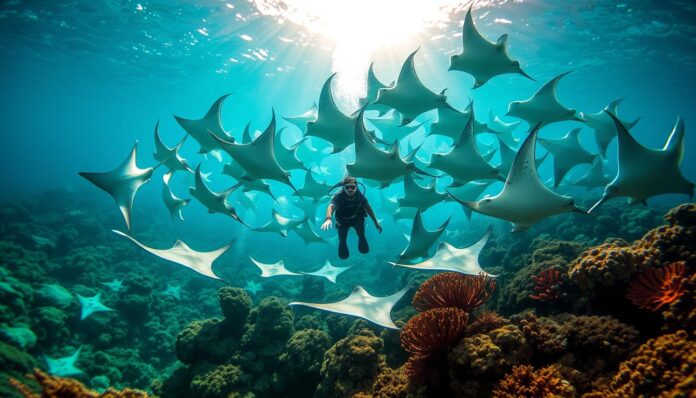Did you know that over 70% of divers find stingray encounters unforgettable? At Stingray City in Grand Cayman, the excitement of marine life is unmatched. These creatures turn a simple dive into an unforgettable journey.
Stingray City is in the North Sound of Grand Cayman. It’s about 500 miles south of Miami. This place is a top spot for those who love diving and want to see marine life up close.
The Southern Caribbean stingrays make the underwater world magical at 12 feet deep. Divers get to connect with marine life in a way that’s rare. Companies like Ambassador Divers offer personal tours with small groups. This makes every dive special and intimate.
Key Takeaways – Diving with Stingrays
- Stingray City offers unique underwater interactions
- Diving depth is approximately 12 feet underwater
- Tours are personalized with small group sizes
- Suitable for both experienced divers and beginners
- Located in the stunning North Sound of Grand Cayman
Why Scuba Dive with Stingrays?
Diving with stingrays turns a regular dive into an amazing adventure. These incredible creatures let us see the ocean’s depths in a special way. It’s an experience unlike any other eco-tourism attraction.
Unique Encounter with Marine Life
Stingrays are some of the most interesting sea animals. Their smooth moves and ability to adapt make them great friends under the sea. Divers get to see these gentle giants up close, moving through the water with ease.
- Observe stingrays in their natural habitat
- Experience their smooth, gliding movements
- Witness fascinating marine behavior up close
Educational Opportunities
Scuba diving with stingrays is a chance to learn about the sea. You’ll discover how stingrays live, behave, and why we need to protect them. With 69 types of Whiptail Stingrays around the world, every dive is a lesson.
| Stingray Characteristics | Details |
|---|---|
| Disc Width | 30 cm to over 2 meters |
| Tail Barb Length | Up to 20 cm |
| Group Name | A “Fever of Rays” |
Thrill and Adventure
For those who love adventure, diving with stingrays is thrilling. The excitement of swimming with these amazing creatures is unforgettable. Every dive is a chance for a thrilling encounter with sea life.
“In the underwater world, stingrays dance with a grace that transforms fear into wonder.” – Marine Biologist
Best Locations for Stingray Diving
Exploring the world’s best stingray diving spots is an unforgettable adventure. You’ll find crystal-clear waters in the Cayman Islands and other global hotspots. Stingray encounters are thrilling for divers of all levels.
Grand Cayman: The Ultimate Stingray Encounter
Stingray City in Grand Cayman is the top spot for marine lovers. It’s in the North Sound, with extraordinary interactions with Southern Stingrays in clear waters. Key highlights include:
- Protected environmental zone exclusively for divers
- Maximum dive depth of 12 feet
- Short 10-minute boat ride from Cayman Islands Yacht Club
- Ideal diving months: May to November
Exploring Stingray City
The Cayman Islands’ Stingray City is a unique diving experience for all. Visitors can expect:
- Interactions with naturally docile Southern Stingrays
- Comprehensive safety briefing before diving
- One-tank afternoon dive option
- Water depths of just a few feet
Other Notable Stingray Diving Spots
Diving with stingrays is a captivating experience that can be enjoyed in various stunning locations across the globe. Whether you’re seeking encounters with graceful eagle rays or the fascinating southern stingrays, here are some of the best destinations categorized by regions:
Asia:
- Maldives: The Maldives, with its pristine turquoise waters and vibrant coral reefs, offers excellent opportunities to encounter various species of stingrays, including manta rays. Baa Atoll and Hanifaru Bay are renowned hotspots for these majestic creatures.
- Thailand: The Andaman Sea and the Gulf of Thailand are home to several stingray species. Koh Tao and the Similan Islands are popular destinations known for their diverse marine life, where you can encounter both reef and eagle rays.
- Mozambique: The warm waters of Mozambique are a haven for marine life, including stingrays. Ponta do Ouro and Tofo Beach are famous for their encounters with reef and giant manta rays, providing unforgettable diving experiences.
- Seychelles: The Seychelles archipelago boasts exceptional diving sites where you can swim alongside various species of stingrays, including the impressive manta rays. Sites such as Beau Vallon and the Aldabra Atoll offer remarkable encounters.
Caribbean:
- Cayman Islands: The Cayman Islands are renowned for their vibrant marine life, and Stingray City is one of the most famous dive sites in the world. Here, you can have unforgettable interactions with southern stingrays in crystal-clear waters.
- Bonaire: Located in the Dutch Caribbean, Bonaire is a paradise for divers. Klein Bonaire is a popular spot to encounter southern stingrays, which can be found gliding gracefully along the sandy bottom.
- Belize: Belize’s Barrier Reef, a UNESCO World Heritage Site, is a haven for marine biodiversity. The famous Hol Chan Marine Reserve is a must-visit destination to dive with southern stingrays and other captivating marine species.
- Honduras: The Bay Islands of Honduras, including Roatan and Utila, offer exceptional diving opportunities. Utila is known for its encounters with spotted eagle rays, while Roatan provides a chance to see southern stingrays in their natural habitat.
- The Azores, Portugal: The Azores archipelago in the Atlantic Ocean is a hidden gem for diving enthusiasts. Here, you can encounter a variety of stingrays, including the manta ray, amidst the stunning volcanic underwater landscape.
- French Polynesia: French Polynesia, including the islands of Bora Bora and Moorea, offers unforgettable encounters with stingrays. The clear turquoise lagoons provide an idyllic backdrop for swimming alongside these graceful creatures.
- Australia: The Great Barrier Reef, one of the world’s most iconic diving destinations, offers opportunities to dive with various stingray species. Lady Elliot Island and the Whitsunday Islands are known for their encounters with reef and eagle rays.
- Florida, USA: The warm waters of Florida present chances to encounter stingrays. The Florida Keys, including Key Largo and Key West, are popular destinations to dive with southern stingrays and explore their vibrant underwater world.
- Mexico: Mexico’s Yucatan Peninsula is home to world-class diving sites. Cozumel, Playa del Carmen, and Cancun offer remarkable encounters with eagle rays and southern stingrays, providing unforgettable diving experiences.
- Galapagos Islands, Ecuador: The Galapagos Islands are a UNESCO World Heritage Site known for their incredible biodiversity. Here, you can dive with various species of stingrays, including the iconic giant manta rays.
- Buzios, Brazil: Buzios, located in the state of Rio de Janeiro, offers fantastic diving opportunities. Encounter southern stingrays and other marine species in the clear, warm waters of this picturesque coastal town.
These destinations provide exceptional opportunities to dive with stingrays, allowing you to immerse yourself in their captivating world. Remember to research and select reputable dive operators to ensure responsible and sustainable interactions with these incredible creatures.
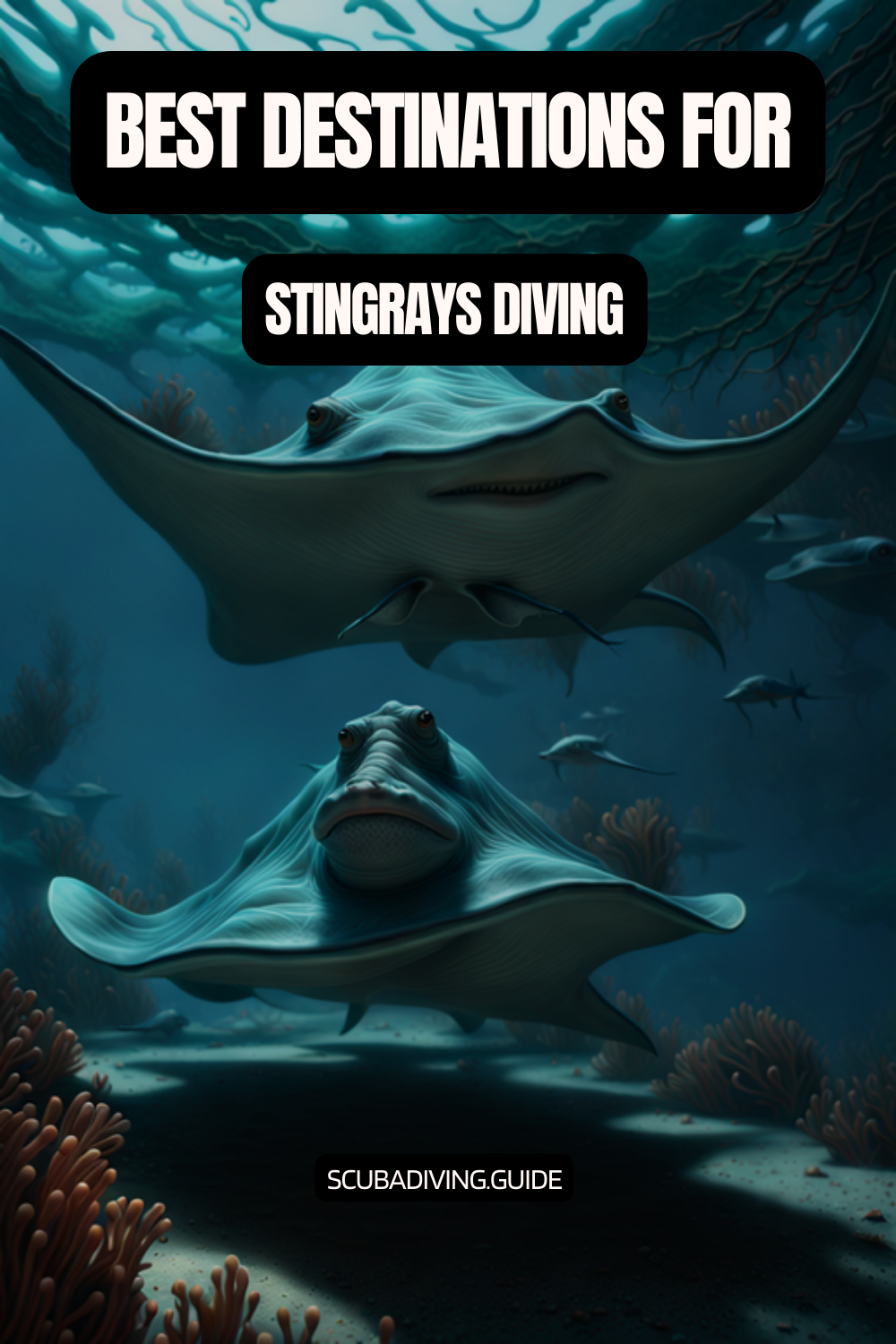
While Stingray City is a top spot, other Caribbean diving spots offer unique stingray experiences. Shark Ray Alley in Belize is another gem, with stingrays and nurse sharks in colorful underwater scenes.
“The magic of stingray diving lies not just in the encounter, but in understanding these magnificent creatures in their natural habitat.” – Marine Conservation Expert
Grand Cayman is known for its stingray experiences. Excursions last about 3 hours and cost around USD 55 or more. The beauty and accessibility of these spots make them a must-visit for marine enthusiasts.
What to Expect During the Dive
Scuba diving with stingrays is an amazing underwater adventure. It offers unforgettable marine encounters. These incredible creatures make every dive special, inviting divers to explore their world.
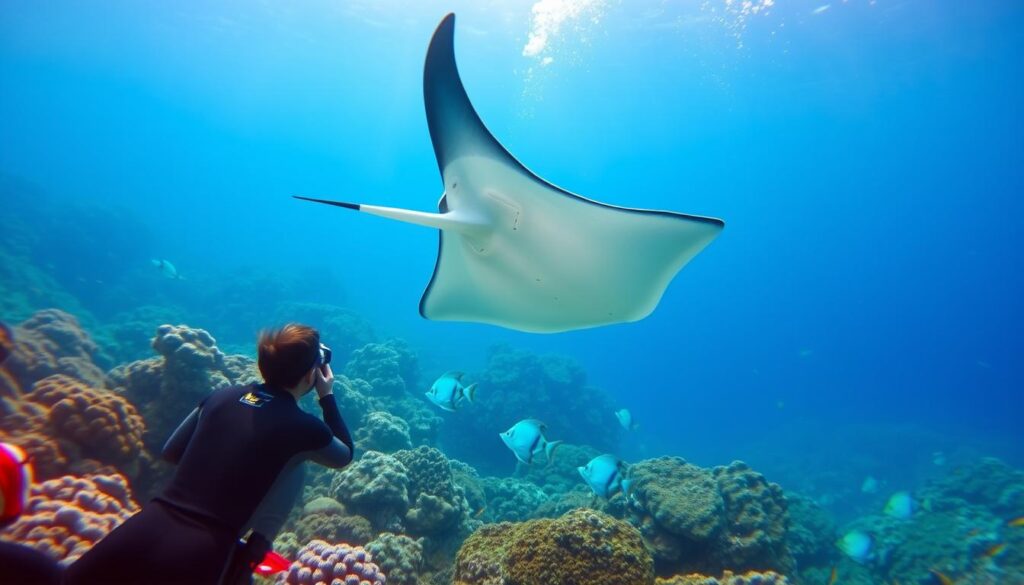
Understanding Stingray Behavior
Southern stingrays, found in Caribbean waters, are fascinating. They can grow up to 5 feet wide. They also show interesting social behaviors with divers.
- Stingrays glide gracefully through water
- They often approach divers with curious behavior
- Capable of generating electrical signals for navigation
Dive Depth and Duration
Stingray diving experiences happen in shallow to moderate depths. Most dives are between 10-30 feet deep. This allows divers to spend quality time with these amazing creatures.
| Dive Characteristic | Typical Range |
|---|---|
| Water Depth | 10-30 feet |
| Dive Duration | 30-60 minutes |
| Average Stingray Interactions | 2-50 rays per dive |
Marine Life Encounters
Scuba diving with stingrays opens up a world of marine life. You might see:
- Tropical fish species
- Wrasses and goatfish
- Small reef sharks
- Colorful coral formations
*”Every dive is a unique journey into the mysterious world of marine life.”*
It’s important to interact respectfully and follow diving rules. This ensures a safe and memorable dive with these incredible creatures.
Safety Precautions for Divers
Exploring the underwater world with stingrays needs careful planning and knowledge. These amazing creatures are mostly calm, but divers must be respectful and informed.
Understanding Stingray Behavior
Stingrays are generally not aggressive. In the U.S., there are only about 1,500 stingray injuries each year. Globally, there have been just 17 deaths from stingray attacks in over 60 years.
- Maintain a minimum 3-meter distance from stingrays
- Avoid sudden movements that might startle them
- Use the “stingray shuffle” technique in shallow waters
Essential Gear for Protection
Having the right gear is important for safe underwater adventures. While no gear can stop stingray stings completely, the right preparation can reduce risks.
| Gear Item | Protection Level |
|---|---|
| Neoprene Diving Boots | Limited (Maximum 7mm thickness) |
| Full-Body Wetsuit | Additional Physical Barrier |
| Dive Gloves | Hand Protection |
Pre-Dive Briefing
Professional guides give vital safety tips for diving with Stingrays. A detailed briefing teaches divers about risks and how to interact safely.
“Respect the marine environment, and it will respect you back.” – Marine Conservation Expert
Being ready for emergencies is essential. If you get stung, get medical help fast and use hot water for 30-90 minutes to ease the pain.
Dive Preparation Tips
Getting ready for scuba diving with stingrays needs careful planning. The right steps can make your dive amazing. Safety, knowledge, and the right gear are key for a great marine adventure.
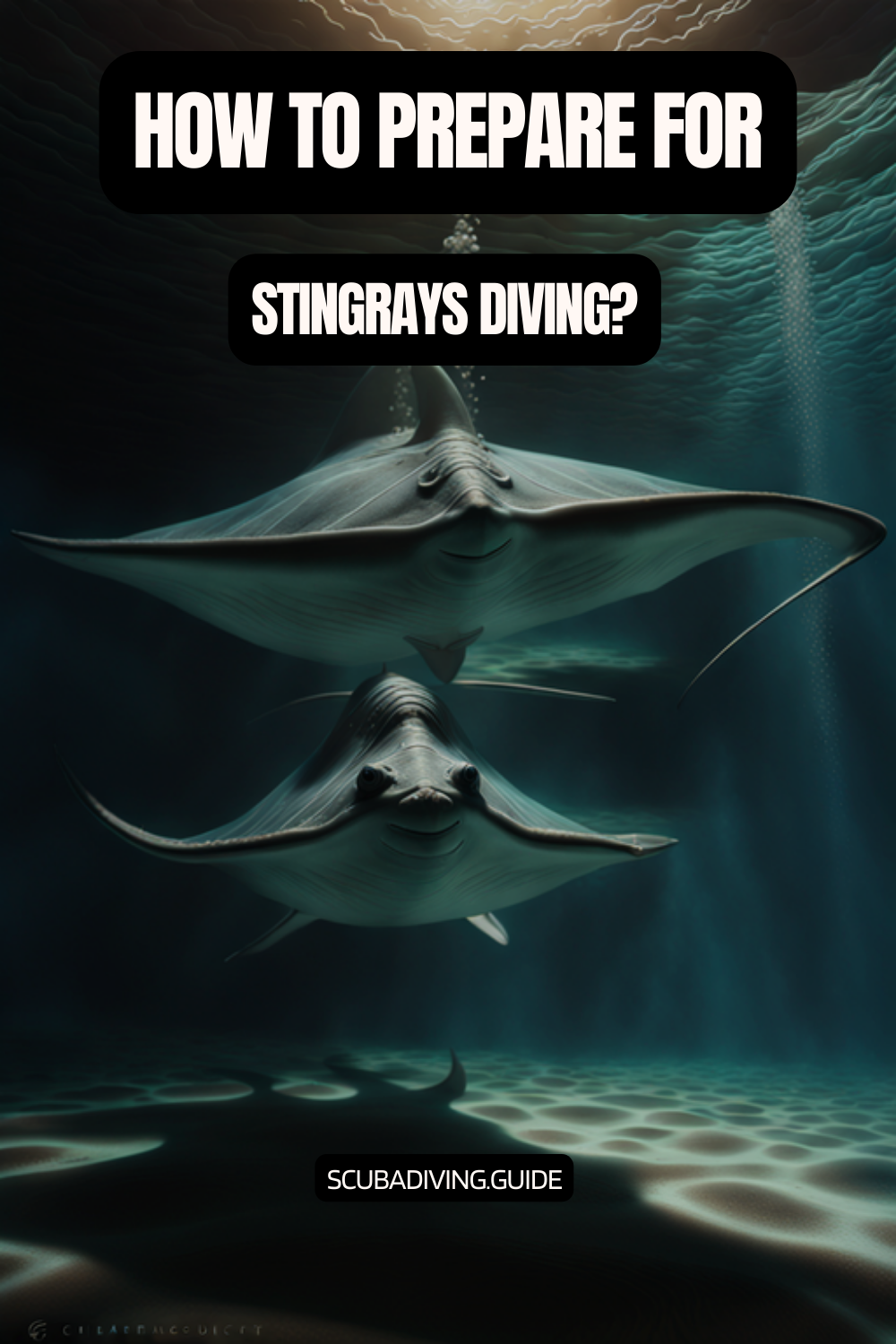
Choosing the Right Equipment
Choosing the right gear is vital for safe diving. Your equipment can greatly affect your stingray diving experience. Here are some important items to consider:
- Well-fitted wetsuit
- Mask with clear visibility
- Reliable dive computer
- Properly maintained regulators
- Backup safety equipment
Training and Certification
Getting the right training is a must for diving with stingrays. Over 70% of certified divers feel significantly safer underwater. Here are some important certification points:
- Complete a recognized diving course
- Choose an instructor with extensive experience
- Obtain Open Water certification
- Practice emergency procedures
“Preparation is the key to unlocking remarkable underwater experiences.” – Professional Dive Instructor
Health and Fitness Considerations
Being physically ready is critical for safe diving. About 10% of people check with a doctor before diving. Here are some health checks to consider:
- Cardiovascular fitness assessment
- Lung capacity evaluation
- Swimming proficiency test
- Medical clearance for dive fitness
By focusing on thorough preparation, divers can have a safe, fun, and memorable time exploring stingrays.
Guided Tours vs. Independent Diving
Exploring Stingray City in Grand Cayman needs careful planning. Divers can choose between guided tours or diving on their own. Each option has its own benefits and challenges.
Benefits of Guided Experiences
Guided tours are great for divers in the Cayman Islands. They offer:
- Expert local knowledge of Stingray City’s marine environment
- Enhanced safety protocols
- Top-quality equipment
- Detailed marine life education
Planning an Independent Dive
Independent diving needs a lot of preparation. You should:
- Get advanced diving certification
- Learn about local marine regulations
- Get marine insurance
- Do a lot of pre-dive training
Choosing the Right Tour Operator
| Criteria | Recommended Qualities |
|---|---|
| Safety Record | Proven track record of secure dive experiences |
| Group Size | Small, personalized groups preferred |
| Conservation Commitment | Active marine ecosystem protection |
| Equipment Quality | Modern, well-maintained diving gear |
“The right guide transforms a simple dive into an unforgettable marine adventure.” – Professional Diving Instructor
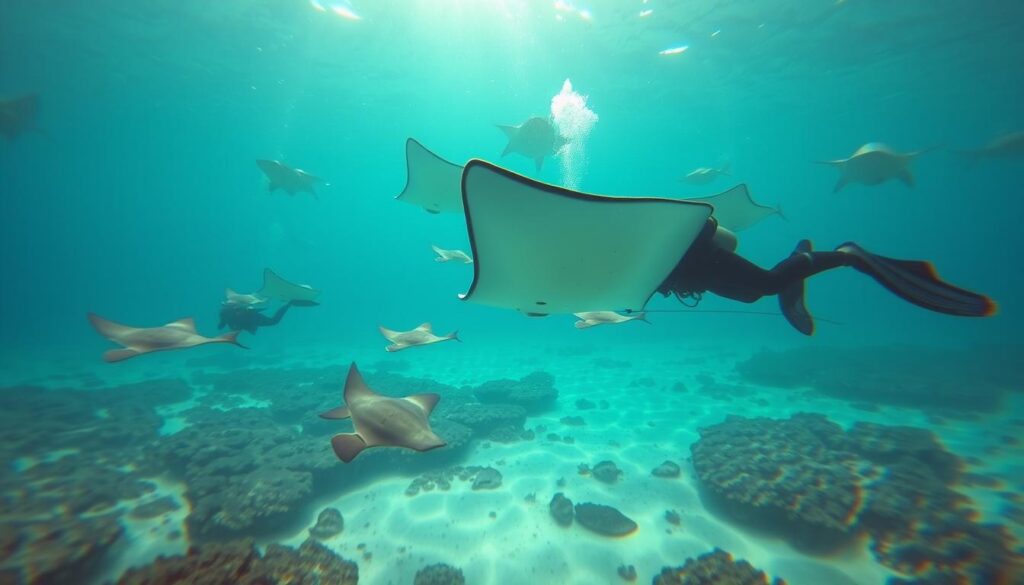
When choosing between guided tours and diving alone in Grand Cayman, think about your experience and comfort. Also, consider your diving goals. Companies like Ambassador Divers offer a safe and memorable stingray experience in the Cayman Islands.
Conservation of Stingrays and Their Habitat
Stingrays are vital to marine ecosystems, with a history over 100 million years old. Yet, they face big challenges in today’s oceans.
Human actions threaten marine life encounters. Right now, 107 stingray species are at risk due to environmental pressures.
Importance of Marine Conservation
Stingray conservation is key to ocean health. These creatures are essential for the balance of marine ecosystems.
- Stingrays help maintain marine biodiversity
- They play a vital role in ecosystem balance
- Their survival impacts entire marine food chains
Responsible Diving Practices
Eco-tourism, like stingray diving, supports marine conservation. Divers can reduce their impact by being mindful.
“Every dive is a chance to protect and preserve marine life” – Marine Conservation Experts
How You Can Help
Small actions can help a lot in stingray conservation:
- Choose responsible tour operators
- Follow marine conservation guidelines
- Support marine protection initiatives
- Spread awareness about stingray conservation
| Conservation Metric | Current Status |
|---|---|
| Threatened Stingray Species | 107 species |
| Marine Protected Areas | 30% of Seychelles waters planned for protection |
| Tracking Research | 60 individual stingrays tagged across 3 species |
By embracing responsible marine tourism, we can help protect these incredible marine creatures for future generations.
Photography Tips for Diving with Stingrays
Capturing underwater adventures with stingrays needs skill and the right gear. You also need to know how to take photos in a way that respects the sea. This means using special techniques that show off the beauty of marine life.
For photographers wanting to capture amazing stingray moments, it’s important to know both the technical and creative sides of underwater photography.
Essential Gear Recommendations
- DSLR cameras with underwater housing
- Wide-angle lenses (100-degree coverage)
- Strobes with adjustable power settings
- Waterproof camera cases
Camera Settings for Perfect Shots
| Camera Type | ISO | Shutter Speed | Aperture |
|---|---|---|---|
| DSLR/Mirrorless | 100-200 | 1/200-1/250 | f/11-f/16 |
| Point-and-Shoot | 200 | 1/250 | f/8-f/18 |
Capturing the Moment
Getting the right shot means knowing where to stand. Use strobes to light up the scene without scattering light. Try to use a shutter speed of 1/200 to 1/250 seconds to freeze the stingrays’ movements.
“Underwater photography is about patience, technique, and respect for marine life.” – Professional Marine Photographer
Best Practices for Underwater Photography
- Scout locations with clear water conditions
- Practice responsible marine photography
- Minimize environmental disturbance
- Adjust camera settings for specific underwater environments
By learning these tips, photographers can turn underwater adventures into stunning photos. These photos will show off the beauty and wonder of marine wildlife.
Common Marine Species Found Alongside Stingrays
When diving with stingrays, you will often encounter a diverse array of marine species that coexist in their natural habitat. These fascinating creatures contribute to the vibrant underwater ecosystem and enhance the overall diving experience. Let’s explore some of the common marine species you may encounter alongside stingrays:
- Reef Fish: Stingrays are often found in close proximity to coral reefs, and therefore, you can expect to encounter a variety of reef fish during your dives. Brightly colored parrotfish, butterflyfish, angelfish, and wrasses are just a few examples of the vibrant fish species that thrive in these reef ecosystems. Their vivid hues and intricate patterns create a visually stunning underwater scene.
- Moray Eels: Keep a keen eye out for moray eels as you explore the reef alongside stingrays. These elongated and serpentine creatures often inhabit crevices and rocky areas of the reef. Their sharp teeth and unique appearance make them both intriguing and slightly intimidating to encounter. Despite their intimidating appearance, moray eels are typically non-aggressive if not provoked and serve as an important part of the marine ecosystem.
- Sea Turtles: Stingrays and sea turtles often share the same habitats, making encounters with these ancient creatures an exciting possibility. Graceful and gentle, sea turtles glide through the water, occasionally surfacing to take a breath of air. Observing their unhurried movements and witnessing these majestic reptiles in their natural environment is a truly remarkable experience.
- Nurse Sharks: Alongside stingrays, you may come across nurse sharks, known for their docile nature and distinctive appearance. These bottom-dwelling sharks are typically nocturnal but can be encountered during daytime dives as well. While nurse sharks can grow to impressive sizes, they pose minimal threat to divers. Observing them from a respectful distance allows for a fascinating glimpse into the world of these captivating creatures.
- Lobsters and Crustaceans: Keep an eye out for lobsters, crabs, and other crustaceans that may be hiding in crevices and beneath coral formations. These fascinating creatures are often masters of camouflage, blending seamlessly with their surroundings. Spotting them requires a keen eye and a willingness to explore the nooks and crannies of the reef.
- Rays and Skates: Alongside stingrays, you may encounter other species of rays and skates. These close relatives of stingrays exhibit their unique characteristics and behaviors. From the spotted eagle rays soaring gracefully through the water to the diamond-shaped guitarfish gliding along the seafloor, each species has its own allure and contributes to the diversity of the marine ecosystem.
- Octopuses and Cephalopods: Cephalopods, such as octopuses and squids, can be found in the vicinity of stingrays, adding an element of intrigue to the underwater experience. These intelligent and adaptable creatures showcase remarkable camouflage abilities and are known for their intricate behavior and hunting techniques. Spotting an octopus or witnessing its dramatic color changes is an extraordinary encounter to cherish.
Encountering these common marine species alongside stingrays amplifies the enchantment and diversity of the underwater world. Each species plays a vital role in maintaining the delicate balance of the marine ecosystem, underscoring the interconnectedness and interdependence of marine life.
Frequently Asked Questions about Stingray Diving
Planning a stingray diving adventure can spark numerous questions for marine enthusiasts. Whether you’re interested in scuba diving with stingrays or exploring snorkeling with stingrays, understanding key details can help you prepare for an unforgettable underwater experience.
Do Stingrays Bite?
Stingrays do not typically bite humans during underwater encounters. These marine creatures are generally docile and curious. While they might occasionally suck on arms or legs while searching for food, serious injuries are extremely rare. Southern stingrays, which can grow up to five feet wide, have been interacting peacefully with humans for generations at locations like Stingray City.
What to Wear While Diving?
When preparing for scuba diving with stingrays, wear a tight-fitting wetsuit that provides protection and allows comfortable movement. Neoprene suits work best for maintaining body temperature and preventing possible skin irritation. Specialized diving gloves can offer additional protection during your underwater interaction with these fascinating marine creatures.
Can Non-Divers Participate?
Non-divers can absolutely enjoy stingray encounters through shallow water experiences or snorkeling options. Many marine locations offer guided tours where participants can interact with stingrays in controlled, safe environments. These experiences allow people of various skill levels to get close to these remarkable animals without extensive diving certification.
FAQ – Diving with Stingrays
Are stingrays dangerous to humans during diving encounters?
Stingrays are usually calm and not aggressive. They are curious when approached with respect. Dive operators in places like Stingray City give safety briefings for safe interactions.
Do I need special certification to dive with stingrays?
Basic scuba diving certification is recommended. But, some tours in the Cayman Islands are for all skill levels. Shallow water experiences might not need full certification.
What should I wear for a stingray diving experience?
Wear a wetsuit or diving skin for comfort. Dive operators often provide gloves and fins. In warm places like Grand Cayman, light wetsuits or rash guards are enough.
How close can I get to the stingrays?
Guides teach you to stay safe and respectful. In Stingray City, you can get close. Move slowly and follow your guide’s instructions.
Can non-swimmers or beginners participate in stingray encounters?
Yes, snorkeling or shallow water experiences are great for beginners. Platforms in Stingray City let you stand in shallow water. It’s accessible for most people.
What time of year is best for stingray diving?
The Cayman Islands are good for stingray diving all year. But, April to June is best for calm waters and clear visibility. Always check local conditions.
How long do typical stingray diving experiences last?
Experiences last 1-2 hours, including travel and briefing. Actual in-water time is 30-45 minutes, depending on the tour.
Are there any age restrictions for stingray encounters?
Age limits vary, but kids as young as 8-10 can join with parents. Some tours offer family-friendly experiences for young kids.
What marine life might I see beside stingrays?
You might see tropical fish, colorful coral, and sea turtles. The marine life varies by location and season.
How can I contribute to stingray conservation during my dive?
Choose eco-tourism that supports conservation. Follow all guidelines, avoid touching marine life, and use reef-safe sunscreen. Supporting local conservation groups is also helpful.
